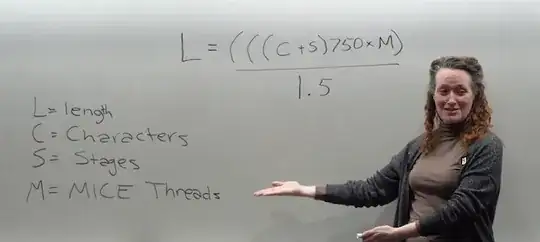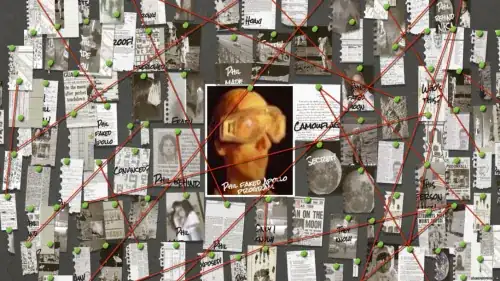Estimating story length
Mary Robinette Kowal uses a word-count formula for estimating the length of a story:
Every character and 'stage' add 750 words (500 - 1000, average) to the story. Kowal assigns 'scenic locations' the same word count as another character. She multiplies that sum by 1.5 for every MICE quotient thread (Milieu, Idea, Character, Event) that must be maintained, each making the story half-again longer.

The formula is explained in this video lecture (Yes, I can see that she wrote the formula with division, but that is not how she explains it).
It's possible Kowal's formula doesn't work for mysteries, but if we apply Kowal's formula to your mystery (why not, it's a metric):
– each of your 5 suspects needs 500 to 1000 words
– assume your detective (1) is 'flat' and does not have a character arc, but has 2 cohorts/assistants/foils
– the victim, even if already dead, is 1 more character
– assuming 1 major 'stage' location described in detail (the crime scene), and 2 more key locations where overlapping suspects worked and lived with the victim
– the MICE thread is at least 1 event (the crime), but with so many suspects probably has all 4 distributed to flesh out various motives
9 Characters + 3 Stages = 12 (x 750 words)
multiplied by 4 MICE threads = 4 x 1.5
This formula suggests 54,000 words – or between 36,000 and 72,000. It's clearly more of a thought-experiment to gauge how story elements will increase word count geometrically.
How long is a good mystery?
A quick websearch suggests most of Agatha Christie's novels are between 50,000 and 60,000 words.
The Mysterious Affair at Styles 59,608
And Then There Were None 54,324
And Then There Were None has 11 characters, 1 location, and easily all 4 MICE in its iconic premise. Kowal's system would estimate 54,000 words – which seems a remarkable coincidence as the plot of Christie's novel means the word count cannot be distributed evenly per character.
Means, Motive, Opportunity
Mysteries are not Romance Genre; you must have more than 3 persons of interest.
The relationship diagram (the 'crazywall' with the photos linked by pins and string) must be more complex than a 3-sided triangle or there is nowhere to add a new string as new connections are realized, new secrets are uncovered, new evidence emerges.

A suspect must have the ability to commit the crime (means), a believable reason to do it (motive), and the chance to carry it out (opportunity). The goal of a detective (and by projection the reader) will be to look for these 3 MMO. Each suspect will begin with 1 (or more), and start 'leveling up' as their secrets are uncovered.
When a suspect gains a new MMO, it's a good reason to interrogate them: 2/3 MMO… but if the 3rd doesn't fit that feels like a red herring. That suspect is downgraded. Fortunately, their answers revealed a secret about another suspect. Bing! Suspect #2 has leveled up and now has 2/3 MMO… Suspects can level up through new evidence. They can also level down. This keeps going. Ultimately each suspect will have their moment in the hot seat when it looks as if they have all 3 MMO.
But you need more than just 3 suspects to maneuver any surprise. A secret relationship levels up 2 suspects because they share the MMO. Another trope changes the time of death and resets certain suspects' Opportunity window, or a new method (Means) is discovered that now includes those previously eliminated. Plot twists will shift the game board, but small evidence is also accumulating making some herrings inevitable (the suspect with the strongest motive who definitely was not there).
You should be able to milk the same 5 suspects multiple times, adding and removing their MMO as the evidence shifts. 3 suspects will show the machinations (the blame has to shift to another suspect; it's either the next guy or the last guy). With 5 suspects you can eliminate 1 early then spring to full MMO later once they are forgotten. A hidden connection can only be discovered once; with 5 suspects (or more) the reader can discover multiple hidden connections, progressing the story while making the mystery less obvious.
How many is too many?
A red herring is a kind of logical fallacy. It's the wrong path.
A young detective will have many – they will jump to conclusions, they will chase the frivolous, they will make rookie mistakes. An old detective won't pursue a red herringl they will have already been burned and stick to what's obvious. Best of all, each is sure the other is wrong. This is great chemistry. The red herrings show their differences – assuming you have young/old detectives.
There's some ambiguity in whether you're saying red herring as a trope within the story, or saying that as an author you are suppose to mislead the reader. I don't think you are suppose to deliberately mislead the reader. I think you should have an MC (detective) who is attempting to include or eliminate persons of interest from a crime.
If the detective has experience (and accountability) they will find subtle ways of testing each suspect without showing their hand, asking leading questions only when they know answers, and looking for signs of those other MMOs. Maybe some of your red herrings aren't literal misdirections, just 'a line of inquiry' that isn't fruitful. The inverse would be a lie that is accepted for truth only to be undone by later evidence, that lie should feel like a red herring because it actually was, but we tend to think of any 'dead end' as a red herring. TV shows are more melodrama than mystery; their emotional tone will telegraph whoever is the current prime suspect. A literary story will involve ambiguous clues and a slower burn, mixed with complicated character drama.
Meanwhile, a comedy buffoon detective will create their own red herrings – there's no way to say how many is too many. You don't want to leave unexplored possibilities on the table, but you don't want to exhaust the premise to the point the reader feels they've fallen into Shaggy Dog territory or an endless loop. As long as the mystery feels like it's still progressing with new revelations to unpack, a variety of suspects will help because you won't over-use any 1.
You don't need my idea of tracking MMO, but it has the logic of telling the detective how to rate suspects, and also how heavily to play their role (are they fishing? Pressuring? Dismissive?). Once all suspects are leveled all the way up, the detective must eliminate them, changing the goals somewhat until the final clues reveal the ending. Suspects do not all have equal prominence as characters, so you must find the balance in an ensemble.

